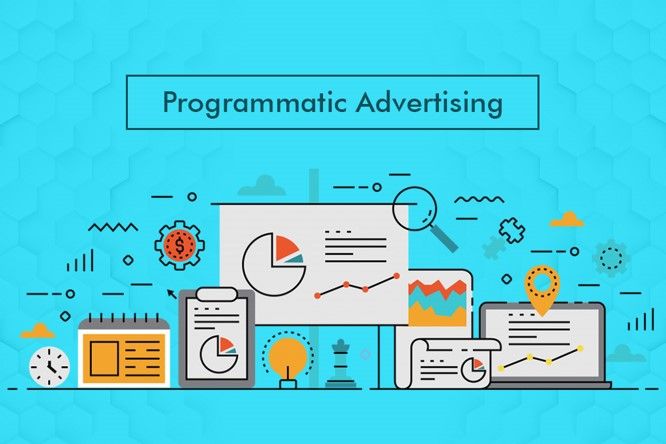Successful Programmatic Advertising Strategy- 8 Steps Plan

In recent times, programmatic advertising has enabled brands to display ads on platforms mostly frequented by their target audience. With more than 90% of digital display ads getting transacted programmatically, there’s no doubt about the success of programmatic ads. But,
What is Programmatic Advertising?
Well, in its basic form, programmatic advertising involves the automated process of selling and purchasing paid inventory online. You can use different programmatic advertising platforms to sell ad inventory to advertisers on publishing sites. Advertisers bid to purchase the inventory and place their ads.
When a visitor arrives on a site using programmatic ads, an automated bidding process starts to display ads to that particular visitor. The publishing site develops the ad space for the viewer on the supply-side platform. It symbolizes the characteristics of the website and the user so that the demand-side platforms can make a bid for the product.
DSPs review the information and give the ad placement a unique value according to the characteristics of the site and the user. While the DSPs bid for the placement of their advertisers, the SSP decides who can place their ad on the publishing site. Since the process takes place within a few milliseconds, programmatic advertising is often referred to as real-time bidding.
Now that you know what is programmatic advertising let’s focus on the steps to make it successful.
1. Conduct Research and Set Goals
You will have to begin by going through multiple programmatic advertising examples. Once you become familiar with the paid ads medium, you can concentrate on setting the goals of your campaign. Since you will come across multiple new ideas and terms, you should try getting accustomed to them.
2. Understand Your Audience
After understanding programmatic advertising meaning, you must focus on defining your audience to make the campaign successful. Map out various characteristics of your target audience, including age, location, the way they use technology, and more. The information will help you create good ads and ensure that you know where to publish them to reach a majority of your target audience.
3. Pick Your DSP
If you understand ‘programmatic advertising meaning’, you will know about DSP. It is the software that will help automate buying ads using real-time bidding technology. After setting the bid for your campaign, the DSP will fight with other advertisers to get ad inventory. The DSP will ensure that your ad is securely placed on prime publishing sites.
4. Define Programmatic Ad Campaign Parameters
Your next task is defining the parameters for your programmatic ads. You will have to settle with an ad type from the available options, including native ads, banner ads, video ads, and in-app ads. Since the CTR is different for each type of these ads, you will have to make your choice correctly.
After that, you must fix the budget and CPM of your programmatic advertising campaign. Some programmatic advertising platforms like Facebook fix the CPM in advance. But DSPs will let you choose the amount you can afford to pay to win impressions.
Once you have fixed the CPM, you should pick the duration and frequency cap of your campaign. It will help determine the number of times your ad will be shown to each user.
5. Select the Targeting Options
Now, you will have to develop distinct personas to define the target audience of your ads. Your target users will be in a particular region, talk in a specific language, have interests in similar things, and use specific browsers to surf the web.
You will need to feed your DSP where you exactly want the ads to appear and who your target audience is for a successful campaign. You will also be able to pick the supply-side platforms from where you intend to generate traffic. Conduct your research to understand what type of traffic is offered by individual SSPs.
6. Launch the Campaign
Now, it’s finally time to launch your programmatic advertising campaign. Upload the creatives to the DSP and specify different attributes like ad markup, length, and breadth. Some DSPs might automatically optimize the dimensions of the ad to make it suitable for different programmatic advertising platforms.
7. Track and Evaluate the Results of Your Campaign
The next step involves analyzing the performance of your campaign from the DSP dashboard. Tracking is crucial because it will help you understand which aspects of your programmatic campaign are working and which are not. You will also be able to figure out how many people have come across your programmatic ad and have interacted with it.
8. Improve the Campaign
After gaining valuable insights from analyzing your programmatic advertising campaign, you need to focus on enhancing it. You should remove all the traffic sources that are not yielding positive outcomes. Instead, make your campaign focused on the traffic sources with high conversion rates.
You will have room for improvement even when your programmatic ads are performing well. You will be able to ensure that you aren’t paying too much for the same ad campaign. Moreover, you will be able to review your campaign goals and ensure that it keeps offering positive outcomes.
Digital Marketing Courses from Emeritus
If you wish to learn about programmatic advertising, you should check out the digital marketing courses from Emeritus. The courses from leading institutions help you become a trained professional in the industry. The programs will make you more noticeable in front of employers and give you a competitive edge over other candidates.
Becoming an expert in programmatic advertising is an extensive journey. But with the right approach and consistent efforts, you will succeed at it. Consider investing in a professional course and learning about the nuances of the advertising technique to receive positive outcomes from it.
Frequently Asked Questions:
What are the major components of a programmatic advertising ecosystem?
The major components of a programmatic advertising ecosystem include the demand side platform, data management platform, supply side platform, and ad exchange.
What is programmatic advertising KPIs?
Programming advertising KPIs are useful for evaluating the success of a campaign in terms of a particular goal.
Are Google Ads programmatic?
Google Ads come with the impact and magnitude of data-driven, programmatic ad buying.
What is the difference between programmatic and PPC advertising?
Programmatic advertising enables digital marketers to enhance the process of buying and displaying online ads. PPC advertising supports the targeting of age and gender demographics within search campaigns.
Can Facebook ads be considered programmatic?
Yes, Facebook ads are a type of programmatic advertising.






